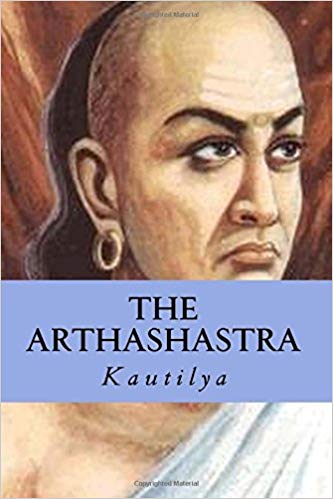Article : Shounak, S. (2015). Ancient Wisdom for the Modern World: Revisiting Kautilya and his Arthashastra in the Third Millennium. Strategic Analysis, 39(6), 710-714.
By Doreen Muyonga
Summary
The author of the article, Shounak Set, is a Research Scholar in the School of International Studies at Jawaharlal Nehru University.
The article principally examines Kautilya’s political teachings and their relevance in the contemporary world. Kautilya was an ancient Indian philosopher and Political advisor to Chandragupta, the founder of the Mauryan Empire in 321 BCE. Kautilya’s Arthashastra, fundamentally elaborates the means of establishing a state and preserving its power in the face of adversarial powers with the inherent danger of political subversion and social instability. Firstly, the article explains Kautilya’s thoughts embodied in his Mandala theory. The author argues that the Mandala theory exemplifies the importance of geography in determining allies and adversaries.
The article then delves into Kautilya’s teachings on power politics and war. Set argues that Kautilya considered state behavior to be contingent on relative power. He further argues that unlike modern realist scholars who see the goal of foreign policy as national interests and suggest that states seek power as an end in itself, Kautilya viewed power beyond simply the currency of politics, but rather as the precise means to the end, which is happiness.
Additionally, Set draws comparison between Kautilya’s Arthashastra and Sun Tzu’s Art of War. The author holds that Kautilya and Sun Tzu guided on tactic and strategy in war. He further submits that Kautilya, in his book the Arthashastra acknowledged the prohibitive expenses of war and cautioned for intrigue and secret offensives, which is in tandem with the teachings of the Chinese war strategist Sun Tzu, who held that the best victories were the ones where aims were achieved without bloodshed.

Lastly, the article discusses the relevance of Kautilya’s writings in the modern era. Set posits that the Cold Start doctrine of the Indian armed forces against Pakistan exemplifies the yana, a practice pursued by stronger powers against weaker powers, as an act of coercive diplomacy short of war. He adds that aid diplomacy in modern times is reflective of Kautilya’s concept of dana.
The author adds that Joseph Nye’s Soft Power concept epitomizes Kautilya’s advice to the conqueror against substituting his virtues for vices of a defeated enemy in governing conquered states. Set concludes that though there has been relative neglect of Arthashastra in the modern age, the writing is a treasure for ageless political wisdom and profound knowledge on human nature.
Critical evaluation
The title of the article, is attention grabbing and well thought out, making the article compelling to read.Set’s choice of Kautilya’s Arthashastra as his focal point of analysis was well informed. It is commendable how Set boldly discusses Kautilya, a classical realist whose excellence, intellect and imagination was unsurpassable. The relevance of the article is also undoubtable since the world we live in today is similar to the world that Kautilya lived in when he built the Mauryan Empire to greatness. The Arthashastra, a ground breaking work on war, statecraft and diplomacy written in 320 BCE has stood the test of time due to its emphasis on state security.
It is regrettable that Set fails to provide a critical analysis of Kautilya’s teachings. He selectively picks Kautilya’s thoughts and haphazardly discusses them without grouping them into themes. For instance, he fails to discuss Kautilya’s teachings on governance, conquest, diplomacy, succession, economics and use of mercenaries and auxiliaries. Set, carefully though, only discusses Kautilya’s views on power politics and war. Though to his credit, the author draws pertinent comparisons of Kautilya’s thoughts on war with Sun Tzu’s Art of War which is quite insightful. It is agreeable that Kautilya and Sun Tzu underscored the importance of strategy and tactics in wars. Kautilya advised on the use of women and spies while Sun Tzu recommended concealment and deception in wars.
Set also fails to provide adequate evidence to demonstrate Kautilya’s relevance in the modern era which is inexcusable. He only discuses Kautilya’s relevance in relation to the Cold start doctrine, aid diplomacy and Soft power. Though Set explains Kautilya’s Mandala Theory, he fails to demonstrate its relevance in the modern age. For instance the border disputes and the economic competition that has characterized the India-China relations can best be explained using the Mandala theory, an issue the scholar shied away from interrogating. Interestingly, Set (2015:1) takes responsibility of this limitations when he concedes that works of scholars of Kautilya’s caliber need scrutiny but he was unable to delve deeper due to time and space limitation.
Though the author’s arguments contribute significantly to the field of International Relations, his failure to cite scholars who have written extensively on Kautilya such as Ilhan Niaz, Pravin Chandrasekaran, and Michael Liebig is quite telling of his grasp of current developments and literature in the field. These also indicates that the author did not conduct adequate research on the subject. Overall, the article is clear, concise and very convincing. It is therefore recommended as an important reading for scholars in the field of International Relations.













